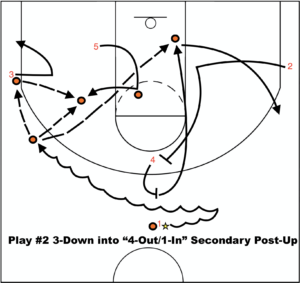Integrating Small-On-Big Screens into your Offensive Schemes

This article discusses various types of off-the ball-screens that are set in various locations of the floor with a smaller offensive player screening a bigger offensive teammate. These various off-ball screens are designed to be difficult to defend and if the opposition elects to take an easier method of defending the screen, the defenders involved have to make defensive switches. These switches then place smaller defenders on the offense’s bigger players and also puts bigger defenders on the offense’s smaller (but most likely quicker) players. These defensive switches can then put the defenders in very difficult situations while giving the offense opportunities to attack those situations.
Different offensive sets/alignments and different plays/entries will have players performing various offensive techniques including a variety of screens in addition to the specific “small-on-big” screens. One similarity with each of the four discussed entries is that if any of these plays break down without producing a shot, all five players will end up in “3-Out/2-In” spot-ups. This gives the offensive team an opportunity for smooth transitions from the entry immediately into various continuity or motion offenses can smoothly begin at that point.


If the inside pass to 04 is turned down by 05, 05 could hit 02 at the high post, skip to 01 on the weakside wing or reverse the ball to 03 at the top of the key. When 03 catches the reverse pass, 05 can make a perimeter-type shuffle-cut either off of 04 or off of 02 through the lane to the opposite side’s mid-post area. After turning down the possible pass to 05, 03 should swing the ball on to 01 on the wing and follow with a diagonal down-screen for 04 to scrape off of to the top of the key. The 03-04 down-screen action helps eliminate the interior support defense that X5 should need to prevent 05 from catching 01’s inside pass as well as position 04 for either a 3-point shot at the top of the key or to easily be able to again swing the ball back to the opposite side of the floor. If shots are not created, players are in the “3-Out/2-In” spot-ups for the offense to easily flow into a designated continuity or motion offense. Diagram 2.

This next entry is out of the “3-DOWN” Set with 01 electing in this diagram to dribble-scrape off of 04’s ball-screen at the top of the key to the offense’s left side. When 05 sees 01 turns the corner, 05 makes a strong duck-in cut into the dotted circle. If X5 plays behind, 01 can easily enter the ball to 05 for a high percentage inside shot. If X5 fronts 05 on his cut, 01 should lob the ball towards the corner of the backboard for another high percentage shot. At the same time that 01 turns the corner, 02 sprints diagonally up from his deep corner area to set a “small-on-big” (back-)screen the (ball-)screener. 04 then scrapes off of 02’s outside shoulder and runs a lob route to the basket. If X4 even slightly hedges out on the dribbler, 04 creates even more space between his defender and himself. If X4 switches out on the dribbler, X1 then would get back-screened by 02 and would have to somehow try to match up to a stronger and taller offensive opponent near the basket. If 04 does not receive 01’s lob pass, he curls back out to the newly declared weakside wing area. If 01 cannot make the initial bounce pass to 05 or the lob pass to 04 rushing to the basket, 01 could make the down pass to 03 (who may have a better angle to make the inside pass to 05 or an open shot against a sagging defender.) Diagram 3.

If shots are not created, 01 should reverse the ball to 02 out on top for 05 to make an isolated strong duck-in cut into the middle of the lane (with no other post defenders near him.) 02 could pass inside to 05 with a bounce or a lob pass dependent upon how X5 tries to deny 05 the ball or he could swing the ball on to 04 on the weakside. As 05 “chases the ball” across the lane, 02 and 01 go to set (small-on-big) stagger-screens for 03 to break out of his deep corner to the top of the key to become the primary 3-point shooting threat. This stagger-screen action also helps to isolate 05 in the new ball-side post action; giving the second half of the play balanced inside and outside scoring threats. If shots are still not produced, all players are in the “3-Out/2-In” spot-ups for the next wave of the offensive attack to smoothly begin. Diagram 4.

The next play discussed is a play executed out of the “3-OVER” that starts with 03 diagonally breaking up and out to the free-throw line extended on his side of the floor. At the same time that 03 makes his cut, 02 dives towards the lane, and when 01 makes the wing pass to 03, 02 continues diagonally across the lane to set a “small-on-big” back-screen for 04 to use to slash across the lane to the new ball-side mid-post area. If X4 does not switch on 02’s (somewhat blind-sides) back-screen seemingly from out of nowhere, he will end up trying to defend his man in an isolated high percentage scoring area. If the defense tries to help X4 out by switching the screen, X2 (a perimeter defender) must try to deny the true offensive post player down in an area where 04 belongs. After passing to 03, 01 flare-cuts to the new weakside wing area, while after screening for 04; 02 steps out to the now vacant top of the key. 05 remains as a scoring threat at the new ball-side high post. 03 looks first to hit 04 and then to 05 inside, then to skip the ball to 01 on the new weakside, and finally to reverse the ball to 02 out on the top of the key. Remember that 03 has the available spacing to also be able to create and drive the ball towards the basket. Diagram 5.

If 03 turns down all of these scoring opportunities, 03 can reverse the ball to 02 who can continue swinging the ball to the opposite side of the floor. 03 immediately shuffle-cuts high off of 05’s high post back-screen or cuts low off of 04’s back-screen and looks for an inside pass from 02 or from 03. After 02 wing-passes to 01, 02 then diagonally cuts through the lane to “small-on-big” down-screen 04’s defender. 04 then breaks to the top of the key looking for a reverse pass from 01, while 05 steps out to the new weakside wing area. 01 can shoot, inside pass to 03 posting up, or to 04 for a possible 3-point shot or to simply start swinging the ball back to the other side. All players have attacked and moved their defenders and have ended up in the same “3-Out/2-In” spot-ups for the designated 2nd wave of attack to smoothly begin. Diagram 6.

Diagram 7 illustrates still another play, but out of the “HI-LO STAX” Set. As 01 approaches the top of the key, 04 breaks diagonally up to set a (big-on-small) long ball-screen for 01 to use to move the ball to the wing area on the right side of the floor. 03 rotates to the top of the key as a potential outside scoring threat. After ball-screening, 04 flare-cuts to the new weakside wing area where 03 started. As 01 approaches the free-throw line extended, 02 then diagonally breaks up across the lane to set a “small-on-big” back-screen for 05 to use as he attacks the newly designated ball-side mid-post. After he screens, 02 steps to the new ball-side high post area as a potential scoring threat. If X5 can survive the back-screen, he still must defend his man in an isolated post-up situation since X4 is in the weakside perimeter area. If the defense feels they have to switch 02’s back-screen; they put themselves in an even more precarious situation. Now a perimeter defender (X2) must try to defend 05 in his familiar territory—the ball-side post. Diagram 7.
» MORE: Integrating Various Types of Stagger Screens into Man Offenses

If and when 01 does not make the inside pass to 05, he can look to hit 02 at the high post or reverse the ball to 03 out on top. When that pass is made, the same shuffle-cut action previously described in Plays #1 and #3 could be executed with 01 shuffle-cutting off of either 02 (high) or 05(low); followed by 03’s “small-on-big” diagonal down-screen for 05 could be executed or this action diagrammed in Diagram 8 could be used. When 03 receives 01’ reversal pass, 02 immediately cuts low to set a “small-on-big” down-screen for 05 to curl tightly off of; all the while looking for the high-low pass from 03. If not open 03 swings the ball to either wing and then would receive a flare-screen from the opposite wing. This would place all five players in the same “3-Out/2-In” spot-ups for the next phase of attack to seamlessly begin. This action illustrates 03 swinging the ball on to 04 and receiving 01’s flare-screen. 03 could have re-reversed the ball back to 01 and flare-cut off of 04’s “big-on-small” flare-screen; with 02 now on the ball-side block and 05 on the weakside block. Diagram 8.
A coach that likes a specific play or two just explained could then become creative and build his own additional plays out of the same offensive alignment/set that fit his team’s strengths and weaknesses and that end up in the same “3-Out/2-In” spot-ups. These plays could but would not necessarily have to include the “small-on-big” screens that the four plays have utilized.
Supplementing the offensive package with more screens would make his team more multiple and less predictable; while still maintaining a high degree of simplicity for the offensive players.









